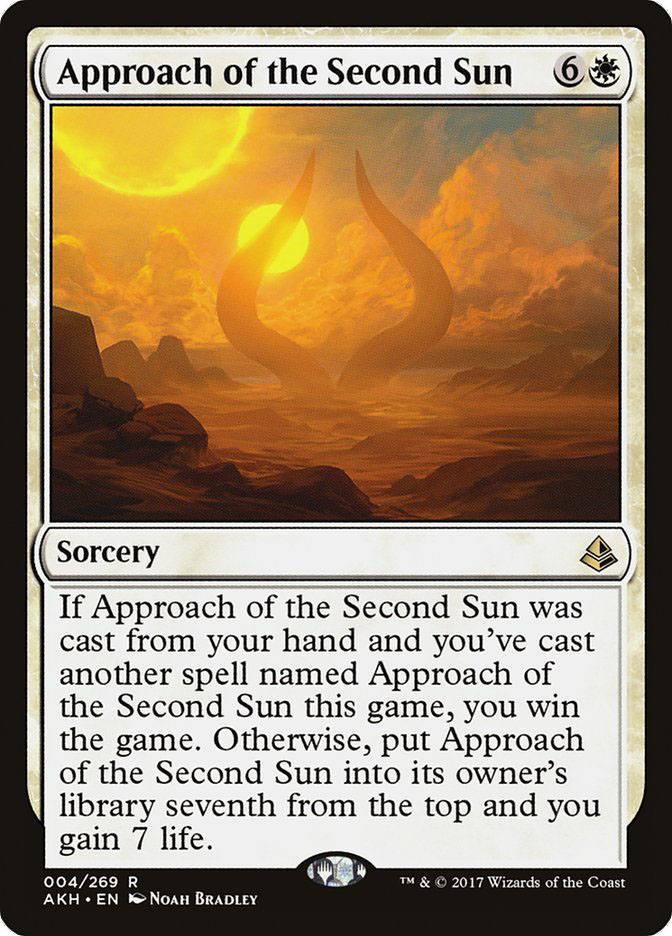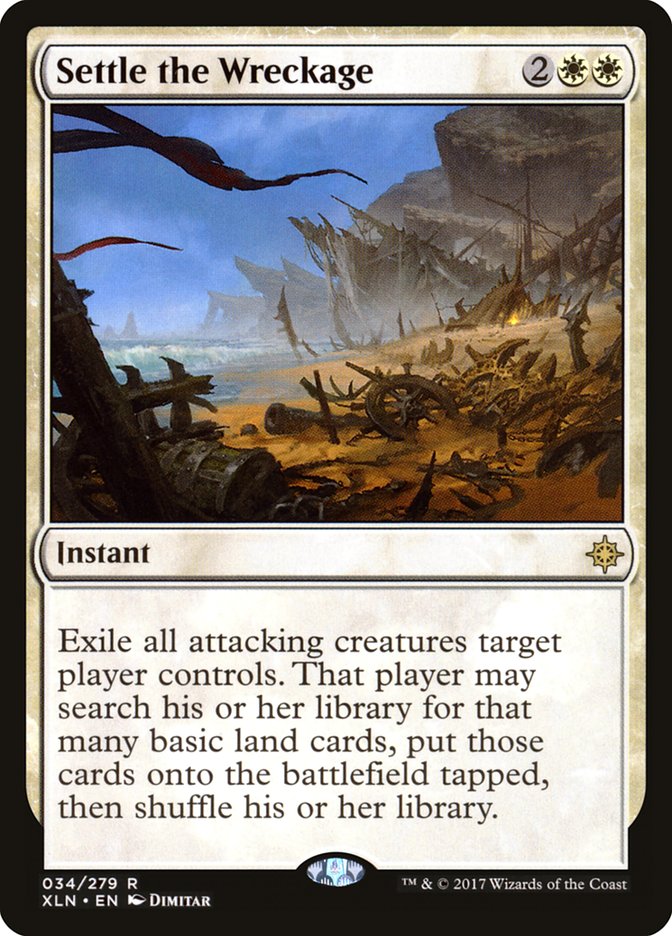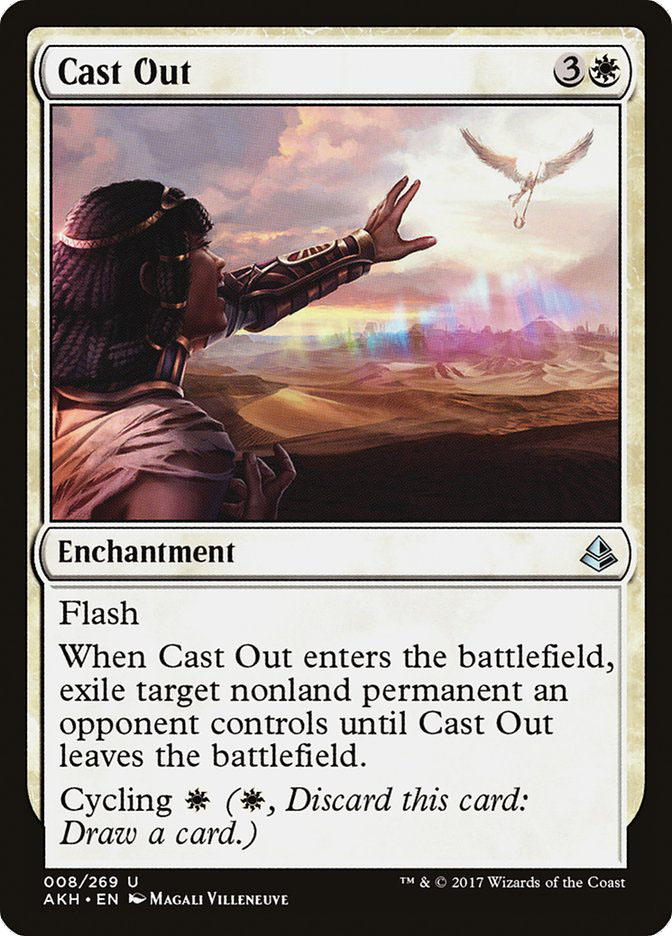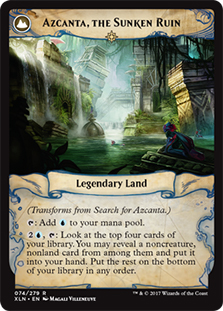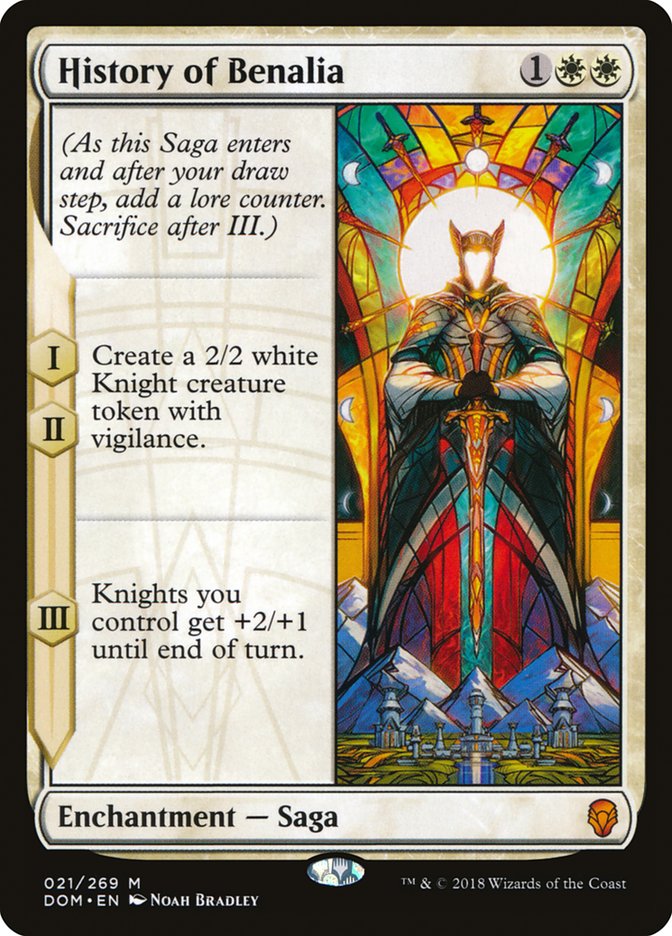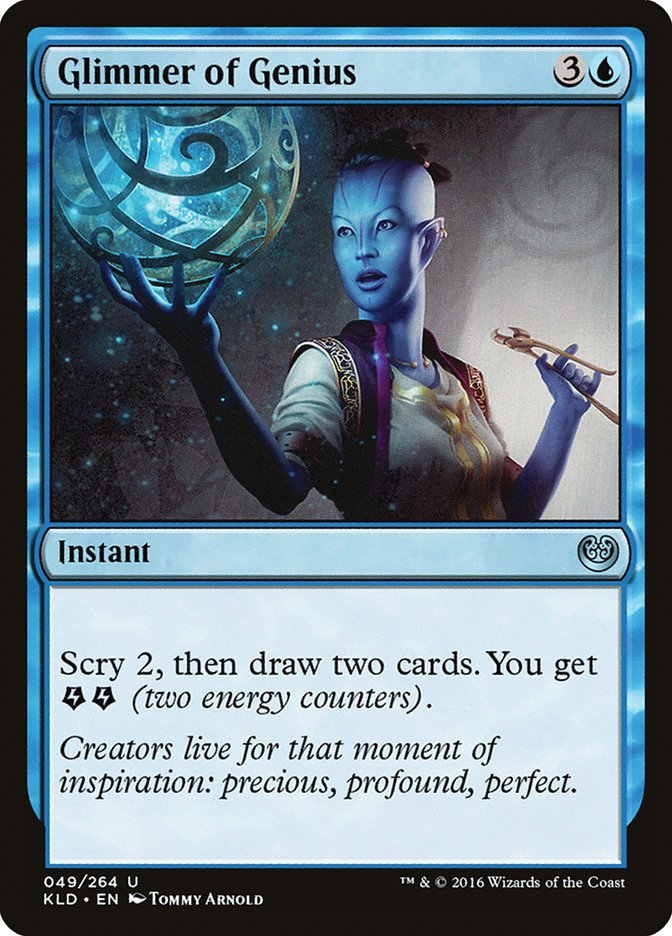Pro Tour Dominaria will go down as one of the most brutal
tournaments of my entire career. At one point in the tournament I was 10-2
after just beating Jon Finkel, up a game in the next match, and easily
winning the second. Then suddenly, I was 10-4 with another “what could have
been” story ready to be told. The only blemishes to look back on were those
that I caused through mistakes. I played so unbelievably well, yet just bad
enough to be looking in from the outside once again.
I guess there’s always next time.
My weapon of choice for this event was W/U Approach of the Second Sun. A
card many had forgotten about, including myself, and one that everyone just
assumed was still a bad card when reminded of its existence. It took
Genesis teammate Martin Muller explaining to me why Approach of the Second
Sun could be a good weapon for us before I could see it for myself (that
kid is really really smart for anyone who doesn’t already know that).
Approach of the Second Sun was a win condition last season, but not a very
good one. The decks that did support this card would have very high game
one win percentages but would crumble to sideboards round after round after
round. Why, you may ask?
Back then, every deck that was even slightly aggressive played
counterspells in their sideboard, making it much more difficult for control
decks to resolve the second copy of Approach of the Second Sun. It also
didn’t help that decks like Temur Energy were still running around that
used Negate in high numbers and could easily punish these control decks
with cards like Longtusk Cub. Things were now different in that most decks
now attack U/W Control with hand disruption, like Duress and Doomfall, and
rarely play counterspells. This makes it much easier to resolve both
“halves” of this expensive sorcery.
Another important thing to take note of when re-evaluating Approach of the
Second Sun for the current metagame is that the most common way to beat
current U/W Control is to make Settle the Wreckage as awkward as possible.
Players had learned to present threats worth countering on the turns an
opponent would leave up mana for this predictable card. Sometimes it didn’t
hurt the U/W Control player in the slightest; but when resources were low,
it could make their lives very awkward. Certain decks like G/B Constrictor
even made that their game plan against U/W Control after sideboard, turning
their entire deck into card advantage and hand disruption. This is where
Approach of the Second Sun would shine brightest even though we assumed the
numbers on this specific deck would be down.
Lastly, Approach of the Second Sun was a nice addition for the U/W Control
mirrors. Not every game gets past the early stages as one player may ride
Search for Azcanta to an early victory, but late game the person with
Approach of the Second Sun in their deck did have a significant advantage
as the opponent would always have to save counters for this win condition.
This made it easier to leverage Teferi, Hero of Dominaria. I don’t think
Approach of the Second Sun is necessary here, but it did give the advantage
to you.
Approach of the Second Sun doesn’t need to be a part of your U/W Control
strategy, but it shouldn’t just get ignored as the metagame evolves. I was
happy playing it at Pro Tour Dominaria and could see myself doing
it again (maybe even this weekend for the #SCGINVI
at #SCGCON).
Let’s get to that primer, as I’m guessing most of you came for that.
U/W Approach Primer
VS R/B Aggro
It’s true that R/B comes in all shapes and sizes, and you must suss out
what you expect is exactly in your opponent’s decks every time you play the
matchup. The big differences are if they play Heart of Kiran or not, but
there’s also wildly different sideboard plans for this matchup. Some
opponents have Arguel’s Blood Fast and Sorcerous Spyglass, while others
won’t have Disenchant targets outside of the eight early artifact
creatures.
None of this really matters for game one, though. They’re the beatdown with
5-10 dead cards in the matchup. Some of those cards could be Cut which
gives them some late game reach, but most of the time these cards will be
used against their own Scrapheap Scroungers. This is one of the main
reasons why I liked our maindeck Approach of the Second Sun game plan as we
didn’t have Torrential Gearhulks in the maindeck that got hit by these
cards rotting away in their hand.
R/B Aggro will try to do their best to resolve good threats like Hazoret
the Fervent or Chandra, Torch of Defiance, and the easiest way for them to
do this is force a Settle the Wreckage to get cast the turn they play one
of these threats. Sometimes this is okay, though, as we have access to two
Blink of an Eye, three Cast Out, and four Teferi, Hero of Dominaria. All
these cards can help deal with problematic permanents. When they play a
premium threat in their first main phase, you can let it resolve. They will
never go “all-in” expecting the Settle the Wreckage. Sometimes you can just
take the hit and play Cast Out on the threat they just resolved.
This is why Cast Out is so important to the deck. Sure, you will cycle
early ones away when you need something in the first few turns, but drawing
into them is never that bad. I even toyed with the idea of playing four but
could never find the room nor would I want that many after sideboard
anyway. Three has always felt like a good number for this effect.
The easiest way to lose a game one in this matchup that was winnable is
usually caused by not prioritizing early counterspells over removal spells.
For example, if you have Seal Away and Disallow in your hand, you should
just take the hit of 3-4 damage countering their next spell. Eventually
you’ll be able to double spell, but at this point your hand won’t be filled
with too many counterspells.
Like I said earlier, it’s difficult to know exactly how to sideboard
against this deck as they can have a variety of different effects. This is
the general sideboard plan we had going into the Pro Tour.
VS R/B Aggro (without Heart of Kiran):
Out (On the Draw):

In (On the Draw):

Out (On the Play):

In (On the Play):

VS R/B Aggro (With Heart of Kiran):
Out (On the Draw):

In (On the Draw):

Out (On the Play):

In (On the Play):

The plan is pretty simple: get to six mana with Torrential Gearhulk in
hand. It’s also acceptable to have six mana with Negate and Settle the
Wreckage in hand, but all you’re trying to do is weaken the power of Duress
in the late game. This is why Disallow is bad in the matchup, as three mana
is almost always awkward against them after sideboard. You can’t use
Disallow on turn five if you plan to cast Teferi, Hero of Dominaria which
comes up a considerable amount of time. It’s also important to state that
jamming Terferi on turn five isn’t a bad thing even if there’s a high
likelihood of them killing it. Just saving the life, forcing them to play
something less threatening, and giving you the time needed to start playing
out the late game is enough.
I’m not sure how many people got to similar sideboard plans as these, but I
will say they were the most effective in our testing and did work at the
Pro Tour. If you haven’t tried to play with or against plans like this, I
suggest you do before going to your next event as the games play out in a
very unique way.
VS U/W Control
Game one in the mirror can be quite the frustrating affair. First and
foremost, the matchup is all about Search for Azcanta. If someone finds
themselves with one of these in the early game, it can be very difficult
for the opponent to come back, especially since they have the higher
likelihood of drawing the dead cards in the matchup. It’s also important to
note that if you have a Search for Azcanta down that you should almost
always keep a playable card on top. It doesn’t matter if it’s Cast Out,
Blink of an Eye, or another land. There’s so many dead cards in the matchup
that making it more likely to draw one of them is almost always foolish.
If Search for Azcanta doesn’t win the game, the mid-game will come down to
making land drops and resolving Teferi, Hero of Dominaria. This is always a
unique part of the game as drawing cards will always happen, but counters
are a finite resource. It’s one of the reasons why you should almost never
counter cards like Glimmer of Genius. This means you can’t just counter
every threat your opponent plays and think you’re going to win, especially
since the last person with Teferi and counterspells will be favored.
Instead you need to think about how you’re going to sequence your cards
like Blink of an Eye and Cast Out. Sometimes you’ll protect your cards with
Blink of an Eye, but other times it can be used as another removal spell.
Let’s say you have a Cast Out exiling a Teferi. If your opponent plays
another one, you can Blink of an Eye your own Cast Out forcing them to get
rid of one with the Legend Rule. Then you can try to Cast Out the one that
is left. This is a great way to deal with opposing threats without needing
to exhaust a precious counterspell.
It’s also important to note that Syncopate may look like it loses value in
the late game, but that doesn’t mean you should ever discard one. Sometimes
a counter war will ensue being won by Syncopates, but other times you may
just tap out with a Syncopate to counter something they can’t/won’t fight
over.
Syncopate: good to the last (land) drop!
Out:

In:

If you believe your opponent doesn’t have any creatures of value, just
bring in Sorcerous Spyglass over the last Essence Scatter. It might also be
correct to bring it in if you know they have Gideon of the Trials or other
problematic permanents.
Sideboard games in the mirror play out nothing like they do in game one.
These games are more tempo-based as both players have access to cheap
threats, like Walking Ballista and History of Benalia, paired with a high
density of Negates. Gameplay changes after sideboard, and one of those
things is whether you should counter Glimmer of Genius or not. Sometimes
when you can counter it, it’s correct to stop them from drawing two cards.
Other times, it’s not.
It’s also important to play threats out if you’re low on counterspells, as
you need to trade resources early if you fear they may get a tempo
advantage having more reactive spells than you. That doesn’t mean you
should slam History of Benalia as early as possible, but sometimes just
play one on your fifth turn and let it get countered because it’s easy to
fall behind in the mirror.
I’m a big fan of Walking Ballista in the mirror as a great way to spend
unused mana, but also how great it is at threatening Teferi. A decent
amount of the time Teferi will answer itself, and that’s the perfect time
for a Walking Ballista to take over the game as you can deal with their
first Planeswalker and threaten the next one.
VS Mono-Red Aggro
Mono Red Aggro is very similar to R/B Aggro with the big difference being
their actual burn spells. They just have less dead cards in the first game
and will win more games where they get you down to a low life total. That
said, they also lose a higher percentage of games due to not being able to
interact with your hand.
Out (On the Draw):

In (On the Draw):

Out (On the Play):

In (On the Play):

Again, I really hate Disallow in these matchups as it’s so difficult to
line up well given how important Settle the Wreckage is in the mid-game.
Negate may seem out of place, but thinking about it will change your turn.
The most important spells they have will win the game. Both Chandra, Torch
of Defiance and Fight with Fire become their backbone strategy if the early
assault doesn’t work. We clearly have enough resources to take care of
creatures, making it important to deal with these windmill slam spells in
the later turns.
VS B/U Midrange
There’s a million different variations of this deck, but the one thing to
keep in mind is that Approach of the Second Sun is a perfect threat against
them game one. We expected decks like this to be popular as they can
actually grind out U/W Control game one with cards like Supreme Will,
Vraska’s Contempt, and Torrential Gearhulk if they want–not to say it’s
that easy, but it’s possible. Approach of the Second Sun gets around all
their removal for Teferi, Hero of Dominaria, making it very easy to win
long games in these matchups.
Out:

In:

The third Negate, History of Benalia, and Invoke the Divine are all options
as well, but are dependent on the situation. I will sometimes bring in
History of Benalia on the play, but I find they just don’t have enough late
game to win once we get there. Approach of the Second Sun will have more
hate for it now, but that just means a few counterspells. I don’t expect
more than three-to-five, three being the most likely.
VS G/B Constrictor
This was the matchup that started our exploration of Approach of the Second
Sun. It seemed like the deck was going to be popular a couple weeks out
from the Pro Tour, but the metagame adapted within that time making it seem
like a bad choice. That’s what made it so difficult for us because we
didn’t know how many people would know just how bad the choice was going to
be. Of course, some would still show up with G/B Constrictor, but we
expected it to make up roughly 5-8% of the field, which was enough to stay
course with Approach.
Game one is pretty easy as they don’t have great ways to gain card
advantage, get damage through, or deal with Teferi, Hero of Dominaria. It’s
how they sideboard that makes the matchup so difficult. They have hand
disruption, Lifecrafter’s Bestiary, and additional Planeswalkers, like
Vraska, Relic Seeker and Nissa, Vital Force. Now they just try to gain card
advantage on every turn and prioritize getting on the battlefield with
problematic permanents over dealing damage. This is exactly why we want a
card like Approach of the Second Sun in our deck, as it’s the only way to
win without dealing with everything.
Out:

In:

The plan against G/B Constrictor is very similar to that of R/B Aggro, as
you’re trying to just stay with them. Card advantage, Torrential Gearhulks
threatening Settle the Wreckage, and counterspells all used to stay nimble
and keep getting deeper into your deck. They will slowly gain battlefield
position, but they’ll rarely be dealing you damage, so it’s important to
build up to Approach of the Second Sun as quickly as possible. This is when
Settle the Wreckage goes from barely playable to the most threatening card
every turn since they must deal you damage before you can get to Approach
of the Second Sun for a second time.
This should get you a good head start if you’re interested in casting the
all-powerful “I win” card, but don’t be shy if you have any questions. As
for me, I must now go and beat Team CFB in the Team Standard Super
League,and then get to practice for the #SCGINVI
that’s going down this weekend.
There’s no rest for the wicked! Wish me luck!



